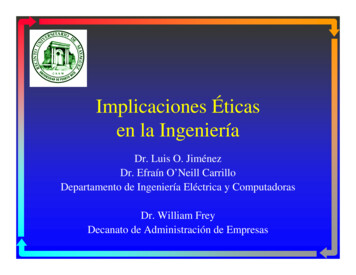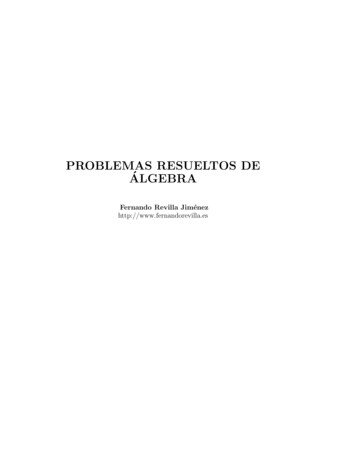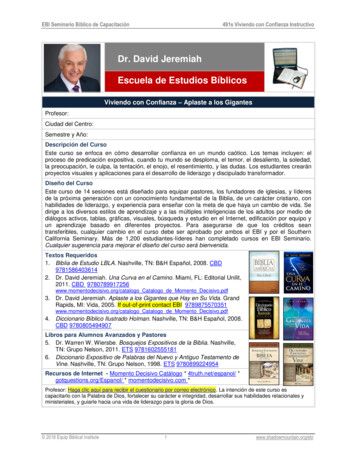
Transcription
Implicaciones Éticasen la IngenieríaDr. Luis O. JiménezDr. Efraín O’Neill CarrilloDepartamento de Ingeniería Eléctrica y ComputadorasDr. William FreyDecanato de Administración de Empresas
“Velar por sobre toda otraconsideración por la seguridad, elambiente, la salud y el bienestar de lacomunidad ”
“A menudo las personas se encuentranlogrando victorias vacías, éxitos conseguidos aexpensas de cosas que súbitamente secomprende que son mucho más valiosas”.F. Covey“Los ingenieros son profesionales que buscanresolver problemas, pero usualmente no hansido entrenados para resolver problemaséticos”.Charles Harris, et al, Engineering Ethics, Concepts and Cases,Wadsworth Publishing Company, 1995, Preface.
¿Por qué enseñar ética?1- Crear conciencia en el futuro profesional sobre como: las ideas que proponga las acciones que realice las decisiones que tometendrán consecuencias tanto directas como indirectas, a corto ya largo plazo, y que parte de su rol como profesional incluirá:asumir responsabilidad por esas consecuencias.Tenemos una responsabilidad profesional y social
¿Por qué enseñar ética?2- Adiestrar profesionales de manera que, las ideas quepropongan, las acciones que realicen y las decisiones quetomen puedan contribuir a: Prevenir desastres Prevenir corrupción Propiciar un balance adecuado entre el desarrollo dela profesión, el desarrollo tecnológico y la calidad devida
Pero ¿Qué es la Ética?
Definiciones de ética y moralEtimología:Griego ETHOSLatín MOS, IS
Definiciones de ética y moralEtimología:Griego ETHOSLatín MOS, ISCARÁCTER; COSTUMBRE o HABITONo hay diferencia etimológica
Diferencia entre la ética y moral Ética: “Disciplina filosófica queestudia racionalmente la conductahumana desde un punto de vistade los deberes y virtudesmorales”. (Ferrer, p. 26) Moral: “Códigos normativosconcretos, vigentes en las diversascomunidades humanas”. (Ferrer p.27)
Diferencia y Relación entre Ética y LeyÉtica y Moral: Permitencritica y reforma de lasnormas legalesCondición para la existenciade normas legalesConcienciaNormas Legales:Salvaguardan mínimosmorales necesarios para laconvivencia socialReputaciónSancionesCódigos normativosconcretos promulgadospor los responsablesde la Sociedad-Pueblo
Const. EEUU Amendment XIII: Prohibition of slavery Section 1: Neither slavery nor involuntary servitude,except as a punishment for crime whereof the party shallhave been duly convicted, shall exist within the UnitedStates, or any place subject to their jurisdiction. Amendment XV: Race and the right to vote Section 1: The right of citizens of the United States tovote shall not be denied or abridged by the United Statesor by any State on account of race, color, or previouscondition of servitude.
Ley:Lo mínimo necesario para vivir enSociedad.La ley no debe dictar la moral, nila moral debe reducirse a la ley.Diferencia entre religión y ética
Pero, ¿no dependen las normasmorales de la sociedad? Una dificultad: todo lo que hemos dicho de laética puede estar muy bien, ¿pero hayprincipios éticos universales? Universalidad de la experiencia moral einnegable pluralidad de los códigos morales ¿Es inevitable la conclusión relativista?
Absolutismo, relativismo yrelatividad El absoluto absolutismo y por qué es inviable El absoluto relativismo: ¿Se puede sosteneren buena lógica? Ni absolutismo ni relativismo El único camino es proteger los derechoshumanos
¿Por que no el relativismo?¿Podrá sostenerse la profesión de ingeniería sillevamos a sus ultimas consecuencias el relativismoético? En términos profesionales: ¿cómodistinguiríamos una practica adecuada deingeniería de una inadecuada? ¿Existiría unconsenso? En términos sociales: ¿cómo sobreviviría ungrupo, una sociedad sin un consenso básico?¿Son entonces relativos:los asesinatos,los robos, el Holocausto en la SegundaGuerra Mundial .?
Condiciones Generales para laPosibilidad de una Ética en elDiseño de Ingeniería
Condición que posibilita laProfesión del IngenieroIntegridad ProfesionalValores relacionados a la verdad, confianza, yhonestidad profesional.La Ingeniería implica relaciones con losclientes, colegas y la sociedad fundamentadasen la verdad, honestidad y confianza
Tres Pecados Capitales contra laIntegridad Profesional en la Ingeniería Fabricación, invención de información o resultados depruebas, estudios o datos de diseños que no se efectuaron. Falsificación de datos, alteración de resultados depruebas, estudios o diseños. Plagio, apropiación de métodos, datos, cuerpo de un texto,trabajos sin citar o reconocer la fuente.
Plagio Cerca de un 70% de los estudiantesuniversitarios admite haberse copiado algunavez Se piensa que pocos son sorprendidos y quelos castigos son poco severos Los niveles mas bajos de plagio seencuentran en lugares donde laresponsabilidad principal sobre integridadacadémica recae en los estudiantes a través deun código de honor Maestros y profesores usualmente noinforman incidentes de plagio
Ejemplo de datos que se han fabricado o falsificado:Pruebas, Riesgo y Costos ¿Se han abaratado los costos sin bajar laconfiabilidad del producto/proceso mas allá de lorequerido? ¿Hemos efectuados las pruebas necesarias paramostrar la confiabilidad del producto/proceso? ¿ Hay condiciones de riesgo para los usuarios? ¿Hay algún efecto negativo en el medio-ambiente?
Ejemplo de Plagio:Propiedad Intelectual Propiedad Intelectual: labor creativa dealguien, en la que invirtió esfuerzo y tiempo. ¿Tenemos derecho de apropiarnos sinremuneración ni reconocimiento para elautor?
Derechos de Autor vs. Plagio Plagio: Usar ideas de otros, sin darlecrédito (aunque no sea palabra por palabra) Tomar la idea de otro y presentarla comopropia No importa el tipo de documento Violación de ética de investigación científica Derechos de autor (copyright) La forma en que se expresa, no la idea. Implicaciones legales Violación de ética de investigación científica
Ejercicio Escribe 5 deberes que entiendas deben tenerlos Ingenieros
EjercicioEscriba tres acciones o actitudes quepodrían estar en contra de laintegridad profesional de uningeniero.
Ética ProfesionalColegio de Ingenieros yAgrimensores de Puerto RicoCIAPRDr. William Frey
Institutionalizing Engineering Practice inPuerto Rico Law 319 (1938): Established the College ofEngineers and Architects and Surveyors ofPuerto Rico (1938) Colegio de Ingenieros, Arquitectos, y Agrimensores dePuerto Rico 1978: Established the Puerto Rico StateSociety of Professional Engineers and LandSurveyors Colegio de Ingenieros y Agrimensores de Puerto Rico(CIAPR)
CIAPR Functions Juridical Entity / Quasi-Public Corporation Determining standards for practicing engineering in PR Developing a code of ethics to establish moral standards forthe practice of engineering Investigating complaints of unprofessional engineeringpractice Investigating and punishing individuals (or corporations)who practice engineering without a license Developing and administering qualifying exams
Requirements for PracticingEngineering Resident of Estado Libre Asociado de PR Good conduct and moral reputation in community Certify absence of criminal conduct and convictions Recommendations from three licensed engineers whohave direct knowledge of moral reputation andprofessional experience Graduated from accredited engineering program Passed both fundamental and specialty exams
Control Over Practice No person who is not a member of CIAPR canpractice engineering in PR Only natural persons can practice engineering CIAPR vs. Autoridad de Acueductos yAlcantarillados de PR Metcalf & Eddy were not allowed to performengineering functions contracted by the AAAbecause they failed CIAPR requirements forpractice Corporations cannot practice engineering in PRexcept when organized as a professionalorganization in accordance with law 185 and theGeneral Law of Corporations of PR
Stakeholder Code developed in1994 Working document shows 15 issues condensed to10. These 10 become CIAPR canons Table correlated CIAPR issues to issues in NSPE,ECPD, IEEE, ASCE, and ASME codes Four Stakeholder Groups emerge from these codes: Public, Client, Profession, and Engineer
Stakeholders Obligations Public Public Wellbeing (health, safety, welfare) Report those who do Client Avoid Conflicts of Interests Maintain confidentiality Profession Uphold the Honor and Reputation of Profession Engineer (Peer) Collegiality Avoid disloyal competition, public criticism ofother engineers, comparative advertising
Principios Fundamentales de Ética ProfesionalCIAPRA fin de mantener y enaltecer la integridad, el honor y la dignidad de susprofesiones, de acuerdo a las más altas normas de conducta moral yética profesional, el Ingeniero y el Agrimensor:1.Deberán considerar su principal función como profesionales la de servira la humanidad. Su relación como profesional y cliente, y comoprofesional y patrono, deberá estar sujeta a su función fundamental depromover el bienestar de la humanidad y la de proteger el interéspúblico.2.Serán honestos e imparciales y servirán con fidelidad en el desempeñode sus funciones profesionales, manteniendo siempre su independenciade criterio que constituye la base del profesionalismo.3.Se esforzarán en mejorar la competencia y el prestigio de la ingenieríay de la agrimensura.
Cánones de Ética Profesional del CIAPREl Ingeniero y el Agrimensor, en elcumplimiento de sus deberes profesionales,deberán:
Cánones de Ética Profesional Canon I Velar por sobre toda otra consideración por la seguridad, el ambiente, la saludy el bienestar de la comunidad en la ejecución de sus responsabilidadesprofesionales. Canon II Proveer servicios únicamente en áreas de sus competencias. Canon III Emitir declaraciones públicas únicamente en una forma veraz yobjetiva. Canon IV Actuar en asuntos conflictos de intereses o la mera apariencia de éstos,manteniendo siempre la independencia de criterio como base delprofesionalismo. Canon V Edificar su reputación profesional en el mérito de sus serviciosy no competir deslealmente con otros.
Canon VI: No incurrir en actos engañosos en la solicitud de empleo y en elofrecimiento de servicios profesionales. Canon VII: Actuar con el decoro que sostenga y realce el honor, la integridad y ladignidad de sus profesiones. Canon VIII: Asociarse únicamente con personas u organizaciones de buena reputación. Canon IX: Continuar su desarrollo profesional a lo largo de sus carreras y promoveroportunidades para el desarrollo profesional y ético de los ingenieros yagrimensores bajo su supervisión. Canon X: Conducirse y aceptar realizar gestiones profesionales únicamenteen conformidad con las leyes y los reglamentos aplicables y conestos Cánones.
IEEE Code of Ethics We, the members of the IEEE, in recognition of theimportance of our technologies in affecting the quality of lifethroughout the world, and in accepting a personal obligation to ourprofession, its members and the communities we serve, do herebycommit ourselves to the highest ethical and professional conduct andagree: 1. to accept responsibility in making engineering decisions consistentwith the safety, health and welfare of the public, and to disclosepromptly factors that might endanger the public or the environment; 2. to avoid real or perceived conflicts of interest whenever possible,and to disclose them to affected parties when they do exist; 3. to be honest and realistic in stating claims or estimates based onavailable data; 4. to reject bribery in all its forms;
IEEE Code of Ethics 5. to improve the understanding of technology, its appropriate application, andpotential consequences; 6. to maintain and improve our technical competence and to undertake technologicaltasks for others only if qualified by training or experience, or after full disclosure ofpertinent limitations; 7. to seek, accept, and offer honest criticism of technical work, to acknowledge andcorrect errors, and to credit properly the contributions of others; 8. to treat fairly all persons regardless of such factors as race, religion, gender,disability, age, or national origin; 9. to avoid injuring others, their property, reputation, or employment by false ormalicious action; 10. to assist colleagues and co-workers in their professional development and tosupport them in following this code of ethics. Approved by the IEEE Board of Directors August 1990
Problemas Éticos enINGENIERIA
¿Qué es un problema ético? “Un problema ético puede ser definido comoun conflicto que la persona experimenta entredos o más obligaciones morales en unacircunstancia particular”.Adaptado de Joseph R. Herkert, Social, Ethical, andPolicy Implications of Engineering, IEEE Press,2000.
Ejemplos de obligaciones moralesque podrían entrar en conflicto Lealtad a la compañía y responsabilidad social yambiental. Garantizar empleo y pérdida económica de unacompañía. Necesidad de empleo para el auto-sostenimiento yoferta de empleo atractiva de compañía con recordque no cumple con las metas éticas y personales. Minimización del costo de productos y preservacióndel medio ambiente Ofertas de empleo: Ser un candidato ético
Ejemplos de problemas éticos Cumplimiento estándares “Favores” Progreso tecnológico vs. ambiente Alternativas Opciones de la Industria: “The natural step” Ingeniería y la responsabilidad social Protección del ambiente o promover el bien
Proceso de Toma de Decisión Ética Exprese claramente el problema ético (¿existe unproblema/conflicto ético-social?) Revise los hechos relevantes (¿cual es el problemareal/técnico?). Identifique aquellos que son afectados. Identifique o desarrolle opciones. Evalué las opciones ¿es práctica? - dimensión técnica. ¿es ética? Seleccione e implemente la opción.
Teorías éticas para evaluar las opciones. Utilitarismo: la mejor acción es la que trae lamejor consecuencia. Ética del deber (deontológica): la mejoracción es aquella que sigue reglas universales. Ética de las virtudes: la mejor acción esaquella que proviene del ser humano virtuosoy lo lleva a su plena realización.
Utilitarismo Principio: El mayor bien para la mayoría. Maximizar las consecuencias, minimizando eldaño. Prueba:(HARM) ¿Hay algún daño? ¿Hace menor daño que lasalternativas? ¿Es el remedio peor que la enfermedad?
Utilitarismo: Sus Dificultades Problema: ¿Cómo se cuantifica elmayor bien? ¿Qué pasa con laminoría? Maquiavelo: El fin justifica losmedios.
Ética del Deber (Deontología) Principio: Una acción es correcta si elprincipio que expresa es universalmenteaplicable (Kant). Las personas deben ser tratadas como fin ensí mismas no como un medio. Regla Dorada: ( ) “Haz al otro lo que quieras que te hagan a ti” (-) “No hagas al otro lo que no quieras que tehagan a ti”
Ética del Deber Ejercicio: Escribe 2 deberes de un ingeniero para con: El cliente La Empresa Asociación Profesional Sociedad
Ética del Deber Prueba (Reversibility) ¿Pensaría que es una buena opción si yoestuviera entre los afectados? “Ponerse en los zapatos de los otros” Ejemplo: Como empleado, Como jefe, Como colega,
Ética del Deber y Códigos de Ética Profesionales Cánones de Ética del CIAPRhttp: //www.ciapr.org/etica canones.html Código de Ética del “National Society ofProfessional Engineering”http: //www.nspe.org/ethics/ Código de Ética del “Institute of Electronic andElectrical Engineering (IEEE)”http: //www.ieee.org/about/whatis/policies Código de Ética del “Accreditation Board forEngineering and Technology (ABET)”http: //csep.iit.edu/codes/coe/abet-a.htm Otros Códigos de Éticahttp: //csep.iit.edu/codes/codes.html
Ética de las Virtudes Principio: El ser humano debe realizar elestilo de vida necesario que lo lleve a su fin,el bienestar. La felicidad ( bienestar) se logra cuando serealiza la misión, la meta del ser humano. Virtud - disposición, hábito, conducta que quelleva a la plena realización del ser humano. Vicios - actos que envilecen y deshumanizanal ser humano. Ser un profesional de EXCELENCIA en todoel quehacer profesional y personal
Ética de las Virtudes Características de un ingeniero virtuoso:Honesto, imparcial, vigilante de la seguridad y bienpúblico, continuo mejoramiento profesional,realice servicios en su área de competencia, eviteconflictos de interés, responsable, su reputaciónprofesional se fundamenta en sus propios méritos,
Ética de las Virtudes Prueba (Publicity): ¿Quisiera o me preocuparía que esta opción fuese dada aconocer en un periódico? “Ojos que no ven, corazón que no siente” Ejemplos: que se enteraran El jefe Empleado Compañía Colegio de Ingenieros Familia Sociedad
Ética de las Virtudes Esta ética requiere un ejemplo de ser humanovirtuoso. Aquel o aquella a quienconsideremos que ha realizado al máximo elbienestar humano. (Ethos - modelo)?
Analogy between designand ethicsDr. William Frey
Analogy between design and ethicsproblemsDesign ProblemConstruct a prototype thatoptimizes (or satisfices)designated specificationsEthics ProblemConstruct a solution thatrealizes ethical values(justice, responsibility,reasonableness, respect,and safety)Conflicts betweenResolve conflicts betweenspecifications are resolved values (moral vs. moral orthrough integration ofmoral vs. non-moral) byspecificationsintegrationPrototype must beEthical solution must beimplemented overimplemented overbackground constraintsresource, interest, andtechnical constraints
Problem-solving in engineering Stages:1. Problem Specification2. Solution Generation3. Solution Testing4. Solution Implementation
Solution TestingSEE HOW YOUR SOLUTIONS STAND UP TO THREEETHICS TESTS AND A FEASIBILITY TESTDr. William Frey
Compare and rank solutions usingpractical and ethical tests Test solutions according to their ethics Reversibility, harm/beneficence, andpublic identification A feasibility test helps you to uncoverand anticipate obstacles to theimplementation of your solution
Proceso de Toma de Decisión Ética Exprese claramente el problema ético (¿existe unproblema/conflicto ético-social?) Revise los hechos relevantes (¿cual es el problemareal/técnico?). Identifique aquellos que son afectados. Identifique o desarrolle opciones. Evalué las opciones ¿es práctica? - dimensión técnica. ¿es ética? Seleccione e implemente la opción.
Pruebas Éticas Prueba (Publicity): ¿Quisiera o me preocuparía que esta opción fuese dada a conocer enun periódico? “Ojos que no ven, corazón que no siente” Prueba (Reversibility) ¿Pensaría que es una buena opción si yo estuviera entrelos afectados? “Ponerse en los zapatos de los otros” Prueba (HARM) ¿Hay algún daño? ¿Hace menor daño que las alternativas? ¿Es el remedio peor que la enfermedad?
Feasibility MatrixFeasibility MatrixResourceTechnicalInterest ConstraintsConstraintsConstraintsTimeCostAvailable AvailableManufac Person- OrganiMaterials, Technology -turabiity alitieszationalLabor, etcLegalSocialCulturalPolitical
Solution Evaluation MatrixSolution /TestReversibilityTestHarm TestPublicityTestCode TestGlobalFeasibilityTestDescription“would I stillthink choice ofthis optiongood if I wereadverselyaffected by it?”“does thisoption do lessharm thanalternatives?”“would Iwant mychoice of thisoptionpublished inthenewspaper?”Does thesolutionpresent anymajor codeviolations?What obstaclesarise that couldprevent theimplementationof this solution?Solution 1Solution 2
Casos (por Dr. Fernando Vega) 1) Un grupo de jóvenes con una excelente idea paraun nuevo producto y generar su propia empresaencuentra un "venture capital" de una persona conmucho dinero. Empieza a producir su nuevoproducto, contrata empleados, adquiere equipos ybienes para la naciente empresa y cuando está amitad de camino, sin tener el producto listo, se dacuenta que la persona está lavando dinero malhabido. ¿Qué se debe hacer?
Casos (por Dr. Fernando Vega) 2) El diseño de sistemas basados en computadoras y lascomputadoras normalmente tiene una obsolescencia muycorta, ejemplo, celulares, IPods, computadoras, etc. Si no segeneran nuevos productos la competencia los saca delmercado o se puede saturar el mercado y entonces la empresapuede desaparecer, en el primer caso y en el segundo seestanca, al menos mientras dura la patente. Despuésdesaparece porque la competencia puede producir el mismoproducto sin haber incurrido en los costos de investigación ydesarrollo. El desarrollo de nuevos productos, sobre todo enhardware tiene un impacto ambiental significativo. ¿Quéalternativas éticas pueden existir?
Casos (por Dr. Fernando Vega) 3) El mismo caso anterior, pero el efecto de latecnología es reducir los costos en lasempresas reduciendo el personal yreemplazando mano de obra por sistemasautomatizados. Es el dilema de la innovacióny la automatización vs. El impacto social deldesempleo de personas.
Ten Principles of AcademicIntegrityBy Donald L. Mc Cabe and Gary Pavela 1. Affirm the importance of academic integrity. 2. Foster a love of learning. 3. Treat students as ends in themselves 4. Promote an environment of trust in theclassroom. 5. Encourage student responsibility for academicintegrity.
Ten Principles of AcademicIntegrityBy Donald L. Mc Cabe and Gary Pavela 6. Clarify expectations for students. 7. Develop fair and relevant forms of assessment. 8. Reduce opportunities to engage in academicdishonesty. 9. Challenge academic dishonesty when it occurs. 10. Help define and support campus-wideacademic integrity standards.
Reconocimiento Este trabajo no se hubiera podido realizar sinla colaboración de los profesores: Dr. JorgeFerrer del Centro de la Ética de lasProfesiones.
Referencias Ian Barbour, Ethics in an Age of Technology, HarperCollins, 1993. Elena Lugo, Ética Profesional para la Ingeniería, Ediciones Riqueña,Librería Universal. M. David Ermann, Mary B. Williams, y Michele S. Shauf, Computers,Ethics, and Society, Oxford University Press, 1997. Charles E. Harris, Michael S. Pritchard, and Michael J. Rabins,Engineering Ethics: Concepts and Cases, Wadsworth PublishingCompany, 1995. Joseph R. Herkert, Social, Ethical, and Policy Implications ofEngineering, IEEE Press, 2000. William Frey and Jose Cruz, Ethics Across the Curriculum Workshop,February 22, 2002. Stephen R. Covey, Los 7 hábitos de la gente altamente efectiva, Paidos,1997. Louis P. Pojman, Ethics: Discovering right and Wrong, WadworthPublishing Company, 1990. Jorge José Ferrer, y Juan Carlos Álvarez, Para Fundamentar la Bioética,Editorial Desclee De Brouwer, 2003.
Portales en la Internetrelacionados al tema Center for Ethics in the Professionshttp://www.uprm.edu/eticawww.cnx.org Markkula Center for Applied Ethicshttp://www.scu.edu/SCU/Centers/Ethics/ National Institute for Engineering Ethicshttp://www.niee.org Institute for Global Ethicshttp://www.globalethics.org Ethics Book Onlinehttp://www.et.byu.edu/ terryr/ethics/
Casos 3) El mismo caso anterior, pero el efecto de latecnología es reducir los costos en lasempresas reduciendo el personal yreemplazando mano de obra por sistemasautomatizados. Es el dilema de la innovacióny la automatización vs. El impacto social deldesempleo de personas.
Stage One:Problem SpecificationA SOCIO-TECHNICAL ANALYSISWILL HELP SPECIFY THE PROBLEM
Use socio-technical analysis to specifythe problem “an intellectual tool to help us recognize patterns in theway technology is used and produced” Constituents: hardware, software, physical surroundings,people/groups/roles, procedures, laws & regulations, data & datastructures STSs embody values A radiation treatment machine must be designed to protect againstover-radiation. How should the designer allocate responsibility forsafety between hardware, software, and the human operator? In otherwords, which parts of the STS should embody the value of safety? STSs exhibit trajectories i.e., coordinated sets of changes These changes, directed by those with economic and political power, canoften lead to injustices For example, what would happen if PR were to adopt an industryexemption like that in the U.S.?
Socio-technical roups, &RolesProceduresLaws,statutes,& regulationsData &DataStorageEngineering projects,products,& technologiesSoftware (CAD,CAM)physicalsurroundings that shapeand channelaction andthoughtIndividuals,groups, &institutionswho fillsocial,professional, andbusinessroles andhaveinterests atstake.STSsexhibitproceduresthatstructurethought andaction andconnectindividualsand groupsSTSs areinformedby laws,statutes,andregulationsEthicalaspects ardware(laptops,desktops,serversand routers
Puerto Rico Socio-Technical SystemEngineering /TechnologyProjectsPhysical andCulturalCharacteristicsPeople,Groups, Curriculum Copper Miningin Puerto RicoIsland betweenNorth and SouthAmericaCIAPR (PuertoLaw 173 (laws12 and 319)AmendmentsSpanish and USColonialExperience936CorporationsABET / ASEEASIBEICIAPRprocedures forbecoming ineeringEthicsPhil. oftechnologyTwo Languages(primarilySpanish butEnglish is alsoimportant)Center forEthics in theProfessions CE (Highway10) CivilEngineering(SuperAqueduct) MechanicalEngineering(Urban Train) ComputerEngineering (EGovernment) tion withUSStatus Debate:Statehood, FreeRico State Societyof ProfessionalEngineers andLand Surveyors)Office ofGovernmentalEthics EngineeringStudents PR engineers PR government PR and USemployersDisciplinaryTribunalABETaccreditation ofengineeringprogramsUS laws andcodes imposedin PREngineeringCodes andGovernmentRegulations (PRand US)EAC integrationprojects(Jimenez andO’Neill in ElecEng)Oficina de protection,continuingEthics Acrossthe Curriculum:OEG ethicsrequirementsQuestionablePractices: Corruption Firmoneria Env. Damage Conflict ofInterests15/85Retreat/Workshop
Stage Two:Solution GenerationDEVELOPING DESIGNS TO REALIZE, BALANCE, ORINTEGRATE VALUE
Realize Values in YourSolution Aim first for a value integrative solution that fullyrealizes the competing values Seek solutions that synthesize, combine, harmonize, or balancethe conflicting values Brainstorming, identifying best practices, abstracting out higherorder goals Aim second for a solution that satisfices, that is, does thebest job of partially realizing the conflicting values Draw the line at integrity, i.e., don t sacrifice an essential moralvalue Value Trade Offs Failing to design value optimizing or value satisficing solutions,rank the conflict values and choose to realize the most important,postponing until later the realization of the less important Do this always as a last resort
Value Profiles from Statement ofValues (ADEM) Justice Be impartial, objective, and refrain from discrimination orpreferential treatment in the administration of rules and policies andin its dealings with students faculty, staff, administration, and otherstakeholders Responsibility: Recognize and fulfill its obligations to its constituents by caring fortheir essential interests, by honoring its commitments, and bybalancing and integrating conflicting interests. As responsibleagents, the faculty, employees, and students of the College ofBusiness Administration are committed to the pursuit of excellence,devotion to the community's welfare, and professionalism. Respect: Acknowledge the inherent dignity present in its diverse constituentsby recognizing and respecting their fundamental rights. Theseinclude rights to property, privacy, free exchange of ideas, academicfreedom, due process, and meaningful participation in decisionmaking and policy formation.
Value Profiles from Statement ofValues (ADEM) Trust: Recognize that trust solidifies communities by creating anenvironment where each can expect ethically justifiablebehavior from all others. While trust is tolerant of and eventhrives in an environment of diversity, it also must operatewithin the parameters set by established personal andcommunity standards. Integrity: Promote integrity as characterized by sincerity, honesty,authenticity, and the pursuit of excellence. Integrity shallpermeate and color all its decisions, actions and expressions. Itis most clearly exhibited in intellectual and personal honesty inlearning, teaching, mentoring and research.
Solution TestingSEE HOW YOUR SOLUTIONS STAND UP TO THREEETHICS TESTS AND A FEASIBILITY TESTDr. William Frey
Compare and rank solutions usingpractical and ethical tests Test solutions according to their ethics Reversibility, harm/beneficence, andpublic identification A feasibility test helps you to uncoverand anticipate obstacles to theimplementation of your solution
Reversibility Test Question: “would I still think choice of this optiongood if I were adversely affected by it?” Imaginative Projection: Projecting yourself intoanother person’s shoes Too much: The other’s view displaces your ownmoral perspective Too little: You never really leave your ownperspective to encounter that of the other Set Up: While remaining focused on agent andaction, reverse with key stakeholders
Harm/Beneficence Test Question: “does this option do less harm thanalternatives?” Imaginative Projection: Project past experience intothe future to determine the likely consequences. Too much: Focus on improbable, long term harmsproduces “paralysis of analysis” Too little: Significant and probable harms are missedin a quick overview Set Up: While focusing on agent compare differentalternatives according to the harms they are likely toproduce
Publicity Test Question: “would I want my choice of this optionpublished in the newspaper?” Imaginative Projection: Project a moral exemplar intothis situation. What would he or she do?
Charles Harris, et al, Engineering Ethics, Concepts and Cases , Wadsworth Publishing Company, 1995, Preface. ¿Por qué enseñar ética? 1- Crear conciencia en el futuro profesional sobre como: las ideas que


